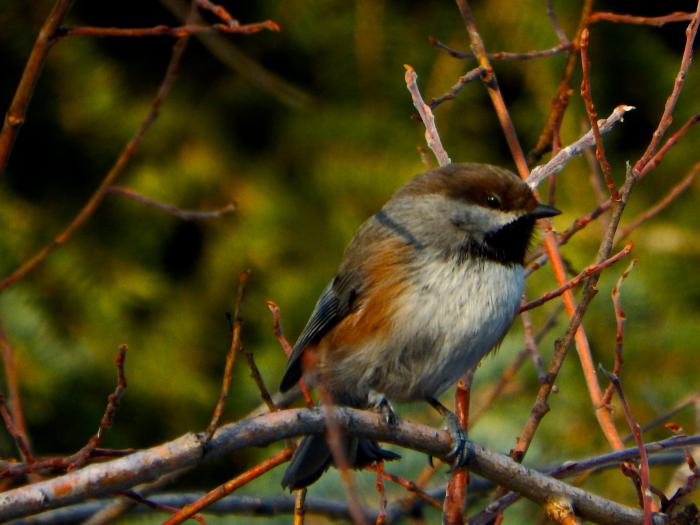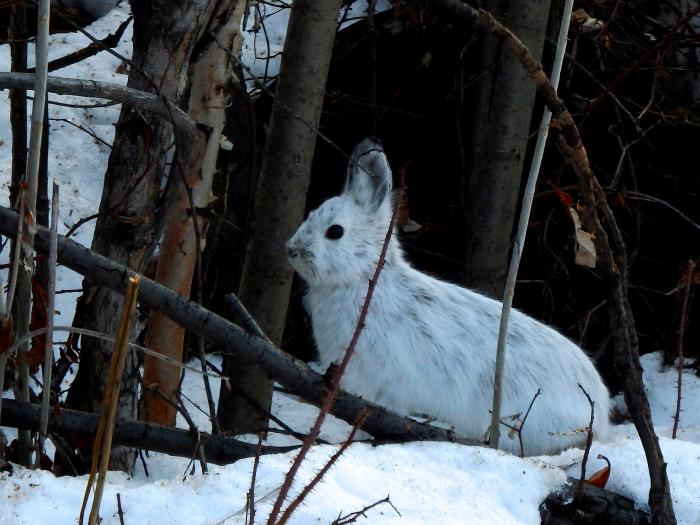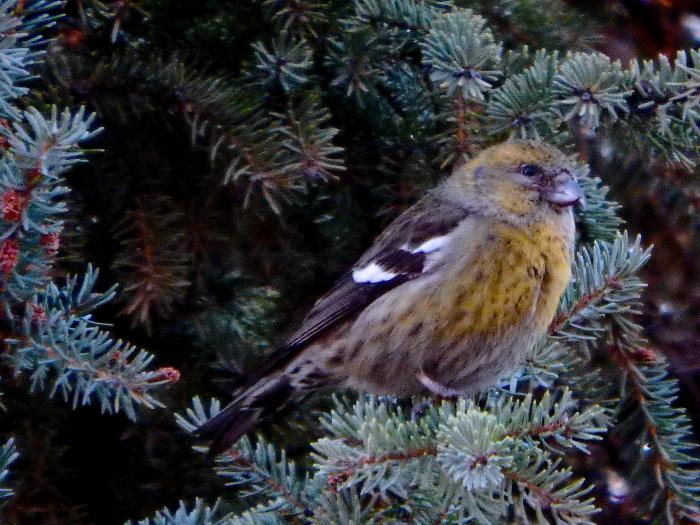First Evening in Alaska
Fairbanks, Alaska
March 30, 2019
Photo of the Day:
 Boreal Chickadee (Poecile hudsonicus). Fairbanks, AK.
Boreal Chickadee (Poecile hudsonicus). Fairbanks, AK.
This week, I'm in Fairbanks, AK for PolarTREC orientation. I'll be getting to meet teachers from around the country, who like me, will be traveling to a polar region (Arctic or Antarctic) to work with field researchers. I'm very excited to meet these teachers and the program coordinators and staff of PolarTREC and ARCUS (Arctic Research Consortium of the United States).
This entry is about my first evening in Fairbanks, which I spent on a walk in the woods near our hotel. When I started at 7 PM, it was still very light outside. Most of the ground was covered with ice, and I had to be careful – at one point, I accidentally post-holed and sank into water below the ice up to my knees.
The wildlife here is completely new to me. Early in my hike, I was greeted by a small hare, completely white and almost indistinguishable from the snowy backdrop of the Alaskan woods. I later showed my photo to Katie Gavenus, a fellow PolarTREC teacher from southern Alaska, and she readily identified this species as a snowshoe hare. This hare's range in restricted to the northern US and Canada, a true specialist of the Alaskan woods. Its name "snowshoe" comes from its large hind feet, which are helpful in preventing it from sinking down into the snow.1 I learned that it in order to blend in with its surroundings, this hare is white in the winter and a reddish brown in the summer.2 Only 5 minutes into my first hike in Alaska, I had already uncovered my first example of evolutionary adaptation to life in the North.
 Snowshoe Hare (Lepus americanus). Fairbanks, AK.
Snowshoe Hare (Lepus americanus). Fairbanks, AK.
Deeper into the woods, I found many birds feeding in the conifers. I identified the boreal chickadee, common redpoll, and white-winged crossbill, all new birds to me. The crossed bill of the crossbill is another beautiful evolutionary adaptation. This bird feeds on seeds from cones of conifer trees, and its bill shape allows it to bite between cone scales and pry them apart by opening its mouth.3
What a great first evening in Alaska.
 White-winged Crossbill, Female (Loxia leucoptera). Fairbanks, AK.
White-winged Crossbill, Female (Loxia leucoptera). Fairbanks, AK.
Arctic Fact of the Day:
I had a great discussion in the van with PolarTREC Project Manager Janet Warburton about frost heaving. Water is unique in that its solid form (ice) takes up more volume than its liquid form. Accordingly, when soil freezes, the result is expansion, or upward swelling. Freeze-thaw cycles can seriously damage roads built on affected soils, and certain stretches of the roads we drove today were very buckled and warped. I'm pretty sure the folks at the back of the van were thrown against the ceiling on multiple occasions (glad I called "shotgun"). According to Janet Warburton, who has spent over half of her life in Alaska, you can use vegetation patterns to predict locations of frost heaving along a road. Paper birch trees prefer soils that are well-drained, so roads traversing stands of birch as less likely to be affected by frost heaving. Black spruce trees, on the other hand, thrive in more hydrated soils, more subject to frost heaving. Sure enough, I quickly learned to hold on for dear life when a stand of black spruce appeared on the horizon.
Arctic Question of the Day:
There is another redpoll species in Fairbanks that looks very similar to the common redpoll I saw earlier today. What is its name, and how do you tell the two Alaskan redpoll species apart?
(Comment below!)
-
Cleveland Museum of Natural History. “Snowshow Hares.” Cleveland Museum of Natural History, http://www.cmnh.org/snowshoe-hares. ↩︎
-
Jones, Matthew R., et al. “Adaptive Introgression Underlies Polymorphic Seasonal Camouflage in Snowshoe Hares.” Science, vol. 360, no. 6395, 2018, pp. 1355–1358., doi:10.1126/science.aar5273. ↩︎
-
Benkman, Craig W. “Adaptation to Single Resources and the Evolution of Crossbill (Loxia) Diversity.” Ecological Monographs, vol. 63, no. 3, 1993, pp. 305–325., doi:10.2307/2937103. ↩︎


Comments
Add new comment